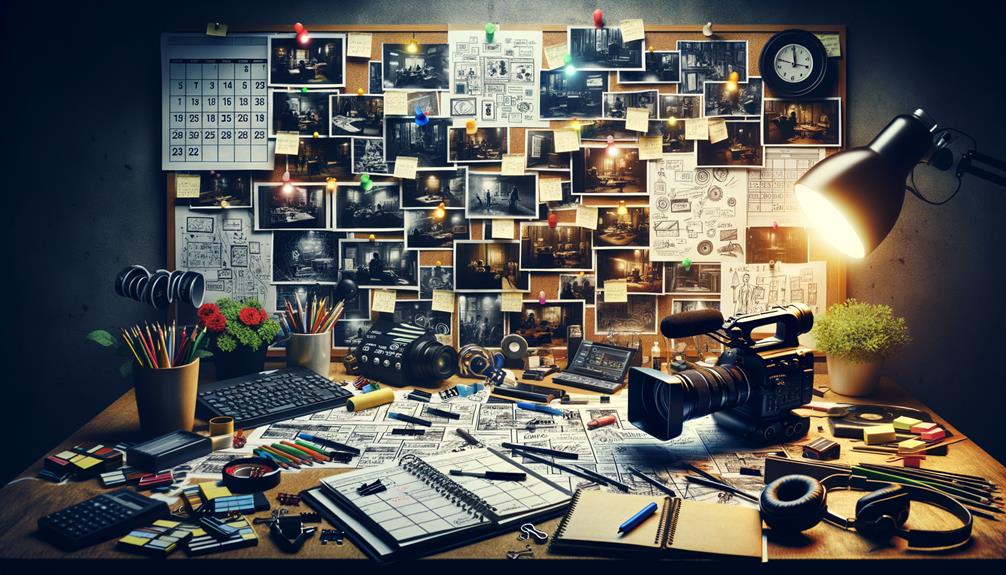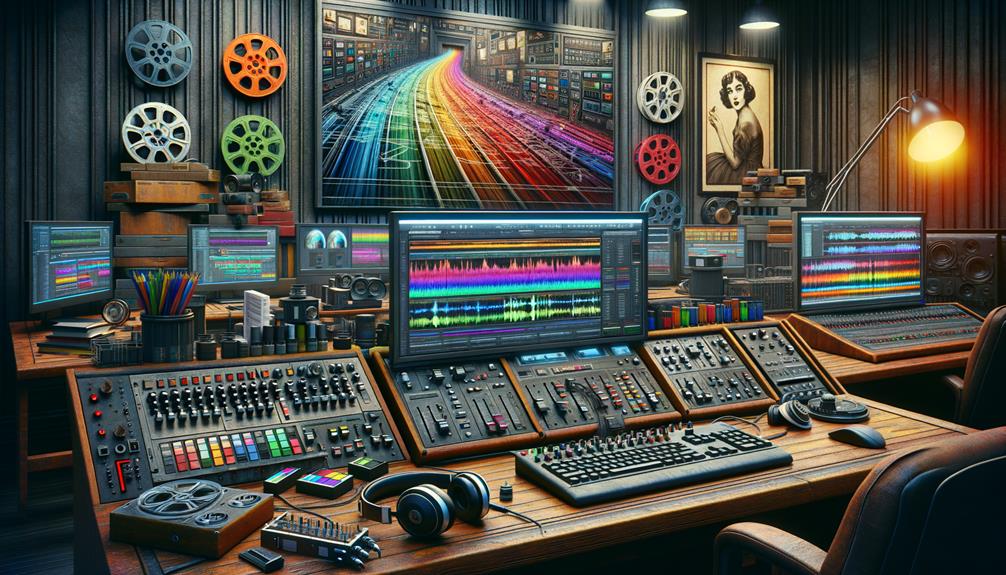I’ve often wondered if there’s a universal formula to producing videos that consistently captivate and engage. Through my years in the field, I’ve discovered that while creativity cannot be formulaic, the process of video production benefits greatly from a structured approach.
This guide aims to share the essence of what I’ve learned, breaking down the complexities into manageable steps. From the seed of an idea to the final product, each phase serves its unique purpose.
But what makes the difference between a good video and a great one? Stick around, and I might just let you in on a few secrets.
Key Takeaways
- Effective video production requires meticulous planning, including scriptwriting, storyboarding, and audience research.
- High-quality equipment, proper lighting, and sound are crucial for professional video production.
- Post-production techniques like editing, color correction, and audio mixing transform raw footage into compelling stories.
- Distribution strategies involving social media, email marketing, and SEO are essential for maximizing video reach and engagement.
Pre-Production Planning

As I embark on the pre-production planning phase, I recognize its critical role in setting a solid foundation for my video project.
Starting with defining my goals, I meticulously script and storyboard, ensuring every scene aligns with my vision and message.
This strategic approach not only streamlines my workflow but also paves the way for a compelling narrative and successful execution.
Defining Your Goals
Defining your goals in the pre-production planning phase is crucial to crafting a video that not only captivates but also communicates effectively with your target audience.
In my journey through video production, I’ve learned that audience research is paramount. It’s about digging deep to understand who they are, what they desire, and how they consume content. This insight shapes a core message that resonates, ensuring my video strikes the right chord.
Developing a comprehensive video strategy is next – it’s my blueprint, detailing every step, from inception to execution. This meticulous planning phase is where visions are aligned, objectives set, and a clear path is charted for the video’s journey. It’s where creativity meets strategy, and ideas begin to take flight.
Scripting and Storyboarding
Once the foundational goals and strategy are set, it’s time to bring our vision to life through meticulous scripting and detailed storyboarding.
Scripting allows me to craft compelling dialogue and vivid scene descriptions that guide actors and crew through each moment. Simultaneously, storyboarding empowers me to visually map out shot sequences, ensuring a seamless flow and dynamic camera angles. Here’s a glimpse into how these elements intertwine:
| Scripting | Storyboarding |
|---|---|
| Dialogue | Shot Sequence |
| Scene Descriptions | Camera Angles |
| Actor Directions | Visual Flow |
| Emotional Beats | Transition Planning |
Essential Video Equipment
Moving on to essential video equipment, I’ll start by sharing some camera selection tips that hinge on balancing budget with performance needs, ensuring you capture crisp, compelling footage.
Then, I’ll guide you through setting up your lighting to achieve that professional look, highlighting how different setups can dramatically alter the mood and clarity of your videos.
Lastly, we’ll explore sound equipment choices, stressing the importance of crisp audio to complement your visuals, and how the right microphone can make all the difference.
Camera Selection Tips
Selecting the right camera is crucial for video production, as it directly impacts the resolution, frame rate, and overall quality of your footage.
When I dive into camera selection, my priority is finding a unit with interchangeable lenses. This versatility lets me capture various shots, from wide landscapes to tight close-ups, with crystal clarity.
I also don’t underestimate the importance of low-light performance. A camera that thrives in dim conditions ensures my projects aren’t limited by the time of day or indoor lighting.
Furthermore, image stabilization is a game-changer, eliminating shaky footage and enhancing the professionalism of my work.
Lastly, I pay close attention to audio capabilities. A camera with superior built-in microphones or the option to attach external ones can dramatically improve the final product’s sound quality.
Lighting Setup Essentials
Understanding the essentials of proper lighting setup is a game-changer in producing videos that boast a professional polish and captivating visual appeal. Mastering the three-point lighting technique, which involves key light, fill light, and back lighting, dramatically enhances the depth and dimension of my videos. Here’s how I break it down:
| Lighting Type | Purpose |
|---|---|
| Key Light | The primary source, illuminating the subject directly |
| Fill Light | Softens and reduces shadows caused by the key light |
| Back Lighting | Separates the subject from the background, adding depth |
Sound Equipment Choices
Why is choosing the right sound equipment crucial for your video production’s success?
Well, sound breathes life into visuals, turning mere images into stories that resonate. Opting for a shotgun microphone ensures my captures are crisp, especially in noisy settings where directionality is key.
I often pair it with a lavalier microphone for those intimate, hands-free interviews, ensuring clear, close-mic’d audio. For dynamic scenes, a boom microphone is my go-to, perfect for snagging dialogue from a distance.
To guarantee that every whisper and shout is recorded in the highest quality, I rely on an audio recorder, independent of my camera’s limitations. And to blend all these sounds harmoniously, an audio mixer is indispensable.
It’s not just about capturing sound; it’s about weaving an auditory tapestry that elevates my visual storytelling.
The Production Process
Delving into the production process, it’s essential to recognize that this journey through pre-production, production, and post-production phases demands not only creativity but also meticulous planning and a committed team’s hard work over months or even years. Each phase brings its unique challenges and triumphs.
- Pre-production: This is where the vision takes shape. I focus on scriptwriting, scouting locations, and strategizing marketing efforts. It sets a solid foundation.
- Production: The action happens here. I’m on set, directing shots, and managing my crew, ensuring every scene aligns with our vision.
- Post-production: The magic of editing software comes alive. I meticulously comb through footage, color correct, and mix audio to bring out the best in our project.
Navigating the production process is a thrilling adventure, requiring a blend of art, technology, and teamwork.
Post-Production Techniques

Frequently, the magic of video production truly comes alive in post-production, where we meticulously edit and enhance raw footage to craft a polished masterpiece. Leveraging video editing software like Adobe Premiere Pro, I dive into the heart of the post-production process. It’s here that I balance the visuals and sound, ensuring every scene flows seamlessly into the next.
| Step | Technique |
|---|---|
| Visual Editing | Adobe Premiere Pro |
| Color | Color Correction |
| Sound | Audio Mixing |
| Organization | Sequencing Footage |
Color correction brightens dull shots, audio mixing clarifies dialogue, and careful sequencing brings the narrative to life. It’s a detailed, creative endeavor requiring both patience and innovation, transforming raw elements into a compelling story that captivates audiences.
Distribution and Optimization
After perfecting our masterpiece in post-production, it’s crucial to focus on how we’ll share our work with the world through effective distribution and optimization. Leveraging enterprise video hosting platforms not only simplifies this process but also provides valuable insights and tools to enhance our video content’s reach.
- Utilize platforms like Vidyard for seamless video distribution, equipped with analytics and security features.
- Benefit from centralized storage and customizable video players to elevate the user experience.
- Integrate with marketing tools for a comprehensive analysis, ensuring our content makes the mark.
Frequently Asked Questions
What Are the 5 Types of Video Production?
I’ve learned there are five main types of video production: corporate, event, commercial, documentary, and educational. Each serves a unique purpose, from training employees to capturing live events and promoting products or conveying educational content.
What Are the Steps in Creating a Video Production?
I start by ideating the video’s purpose, then script it. Next, I plan by scouting locations and organizing equipment. Filming follows, focusing on capturing quality footage. Lastly, I edit the video, enhancing its visual and auditory appeal.
What Are the 4 Parts of Video Production?
I’m diving into the world of video creation, where the journey unfolds in four stages: pre-production’s blueprint, production’s action-packed scenes, post-production’s magic touch, and distribution’s grand unveiling to captivate audiences everywhere. Learn more about it here: https://gisteo.com/video-production-stages
Conclusion
In wrapping up this journey through the world of video production, remember, each project is like a seed that needs nurturing. From pre-production planning to the final stages of distribution, every step is crucial in bringing your vision to life.
Equip yourself with knowledge, passion, and patience. As you tread this path, let your creativity bloom like a flower in spring. May this guide be your sunlight, guiding you to create videos that resonate, inspire, and endure.




